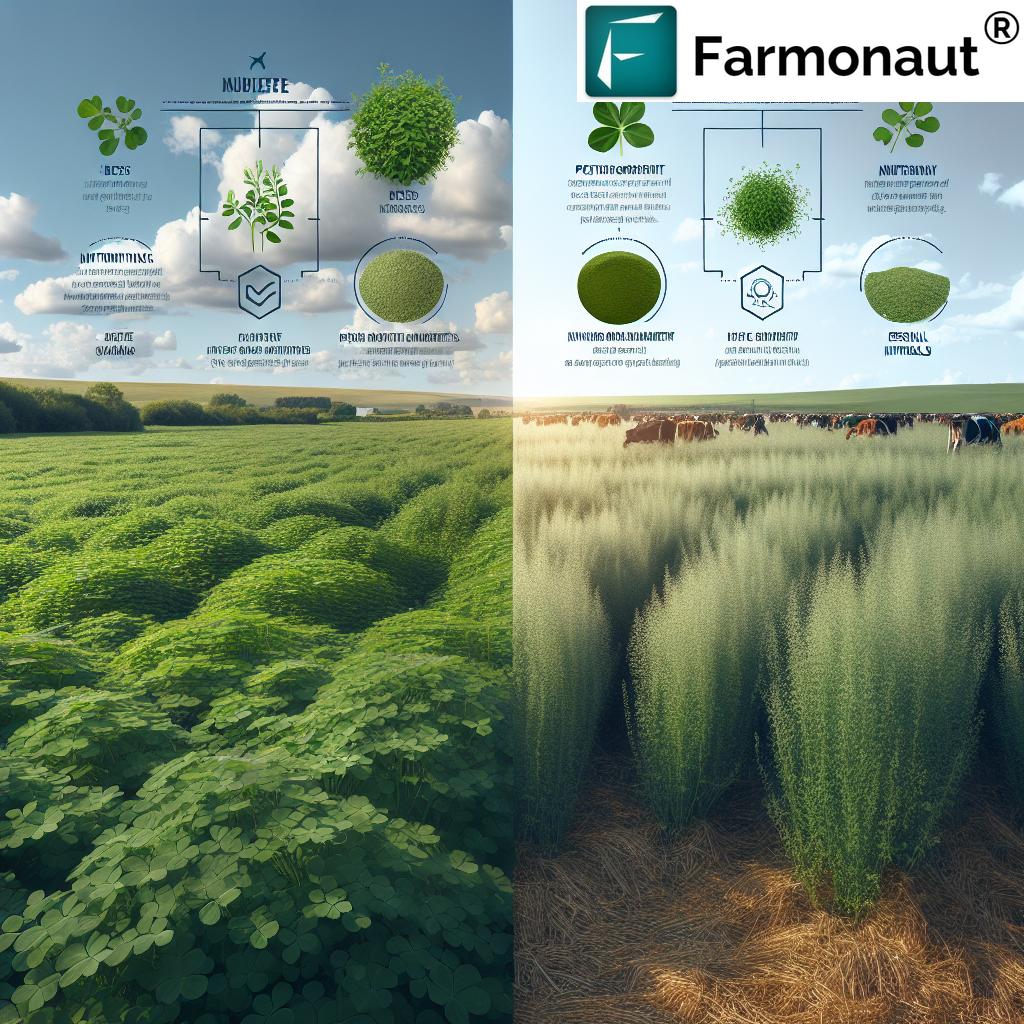Unlock the Power of Alfalfa: Maximizing Nutrient Composition for Optimal Ruminant Nutrition in Fort Atkinson, WI
“Alfalfa can contain up to 25% crude protein, making it one of the most protein-rich forage crops for ruminants.”
Welcome to our comprehensive guide on unlocking the power of alfalfa for optimal ruminant nutrition in Fort Atkinson, WI. As we delve into the remarkable world of this high-quality forage crop, we’ll explore its impressive nutrient composition and why it stands out as a top choice for livestock, particularly dairy cattle. Join us as we uncover the secrets to maximizing alfalfa’s potential and revolutionizing your livestock feed management strategies.
The Nutritional Powerhouse: Alfalfa’s Nutrient Composition
Alfalfa, often referred to as the “Queen of Forages,” has earned its royal title due to its exceptional nutritional profile. Let’s break down the key components that make alfalfa a standout choice for ruminant animal nutrition:
- High Protein Content: Alfalfa boasts an impressive crude protein content, ranging from 15% to 25%, depending on the growth stage at harvest. This high protein level is crucial for supporting milk production in dairy cattle and promoting growth in young ruminants.
- Essential Minerals: Alfalfa is rich in calcium, phosphorus, and other vital minerals that contribute to bone health, milk production, and overall ruminant well-being.
- Digestible Fiber: The forage provides a good balance of digestible fiber, which is essential for maintaining rumen health and promoting efficient digestion in ruminant animals.
- Vitamins: Alfalfa contains significant amounts of vitamins A, D, E, and K, supporting various physiological functions in ruminants.
This nutrient-dense profile makes alfalfa an ideal choice for optimizing livestock feed management and ensuring that your ruminants receive the nutrition they need to thrive.

Alfalfa vs. Other Forage Crops: A Nutrient Composition Comparison
To truly appreciate the value of alfalfa in ruminant nutrition, it’s essential to compare its nutrient composition with other common forage crops. The following table provides a comprehensive comparison:
| Forage Crop | Crude Protein (%) | Total Digestible Nutrients (%) | Calcium (%) | Phosphorus (%) | Neutral Detergent Fiber (%) | Relative Feed Value (RFV) |
|---|---|---|---|---|---|---|
| Alfalfa | 18-24 | 55-60 | 1.2-1.6 | 0.2-0.3 | 40-50 | 140-180 |
| Timothy | 8-11 | 50-55 | 0.4-0.6 | 0.2-0.3 | 55-65 | 80-100 |
| Clover | 15-18 | 55-60 | 1.0-1.5 | 0.2-0.3 | 45-55 | 120-140 |
| Corn Silage | 7-9 | 65-70 | 0.2-0.3 | 0.2-0.3 | 40-50 | 100-120 |
As we can see from the table, alfalfa consistently outperforms other forage crops in key nutritional areas, particularly in crude protein content and relative feed value. This makes it an excellent choice for meeting the nutritional needs of ruminant animals, especially high-producing dairy cattle.
The Symbiotic Relationship: Alfalfa and Ruminants
The relationship between alfalfa and ruminants is truly symbiotic. Ruminants, with their unique digestive systems, are perfectly adapted to extract maximum nutritional value from alfalfa. Here’s how this relationship benefits both the crop and the animals:
- Efficient Nutrient Utilization: Ruminants can efficiently break down and utilize the high-quality protein and fiber found in alfalfa, converting it into milk, meat, and other valuable products.
- Improved Digestibility: The structure of alfalfa leaves and stems allows for better digestion and nutrient absorption in the ruminant digestive tract.
- Nitrogen Fixation: As a legume, alfalfa fixes nitrogen in the soil, reducing the need for synthetic fertilizers and improving soil health.
- Sustainable Agriculture: The use of alfalfa in crop rotations promotes sustainable farming practices and soil conservation.
This mutually beneficial relationship underscores the importance of alfalfa in ruminant animal nutrition and sustainable agricultural practices.
Alfalfa Farming Best Practices in Fort Atkinson, WI
“Fort Atkinson, WI, known for dairy farming, relies heavily on alfalfa, which can yield 4-5 tons per acre annually.”
To maximize the nutrient composition and yield of alfalfa in Fort Atkinson, WI, farmers should follow these best practices:
- Soil Management: Conduct regular soil tests to ensure optimal pH levels (6.5-7.0) and nutrient balance. Implement proper fertilization strategies based on soil test results.
- Variety Selection: Choose alfalfa varieties that are well-suited to the local climate and resistant to common pests and diseases in the Fort Atkinson area.
- Optimal Planting: Plant alfalfa in well-drained soils during the recommended planting windows (spring or late summer) for the best stand establishment.
- Irrigation Management: Implement efficient irrigation systems to ensure adequate moisture, especially during dry periods common in Wisconsin summers.
- Pest and Weed Control: Develop an integrated pest management (IPM) strategy to control weeds, insects, and diseases that can affect alfalfa quality and yield.
- Harvesting Techniques: Time harvests to optimize nutrient content, typically when plants are at 10% bloom for dairy-quality hay.
By implementing these practices, farmers in Fort Atkinson can produce high-quality alfalfa that meets the nutritional needs of their ruminant animals.

The Importance of Forage Quality Testing
While visual assessment can provide some insights into alfalfa quality, laboratory testing is crucial for accurately determining its nutrient composition. Here’s why forage quality testing is essential:
- Precise Nutrient Analysis: Lab tests provide exact measurements of protein, fiber, and mineral content, allowing for more accurate ration formulation.
- Identification of Anti-Nutritional Factors: Tests can reveal the presence of anti-nutritional compounds that may affect animal performance.
- Optimization of Feed Efficiency: Knowing the exact nutrient profile helps farmers and nutritionists optimize feed rations, improving animal performance and reducing waste.
- Economic Benefits: By understanding the true value of their forage, farmers can make informed decisions about supplementation and feed purchases.
Regular forage quality testing is an invaluable tool for maximizing the benefits of alfalfa in ruminant nutrition.
Alfalfa’s Impact on Dairy Cattle Nutrition and Milk Production
In Fort Atkinson, WI, where dairy farming is a significant industry, alfalfa plays a crucial role in supporting high milk production. Here’s how alfalfa contributes to dairy cattle nutrition:
- High-Quality Protein Source: Alfalfa’s high protein content supports milk production and helps maintain body condition in lactating cows.
- Rumen Health: The fiber structure of alfalfa promotes healthy rumen function, which is essential for efficient digestion and nutrient absorption.
- Mineral Balance: The calcium and phosphorus in alfalfa contribute to strong bones and teeth, as well as optimal milk composition.
- Palatability: Cows find alfalfa highly palatable, which encourages increased dry matter intake and supports higher milk yields.
By incorporating high-quality alfalfa into dairy rations, farmers in Fort Atkinson can optimize their herd’s nutrition and boost milk production.
Leveraging Technology for Alfalfa Cultivation
Modern technology can significantly enhance alfalfa cultivation and management. Farmonaut offers cutting-edge solutions to support farmers in maximizing their alfalfa yield and quality:
- Satellite-Based Crop Monitoring: Utilize real-time satellite imagery to track alfalfa growth, detect issues early, and make informed management decisions.
- AI-Powered Advisory: Receive personalized recommendations for optimal planting, fertilization, and harvesting based on local conditions and historical data.
- Weather Forecasting: Access accurate weather predictions to plan field operations and protect your alfalfa crop from adverse conditions.
- Resource Management: Optimize irrigation and fertilizer use with data-driven insights, reducing costs and environmental impact.
By integrating these technological tools, farmers can take their alfalfa production to the next level, ensuring optimal nutrient composition for their ruminant animals.
Explore Farmonaut’s solutions:
Sustainable Alfalfa Production for Long-Term Success
Sustainability is key to long-term success in alfalfa production. Here are some strategies for sustainable alfalfa farming in Fort Atkinson, WI:
- Crop Rotation: Incorporate alfalfa into a diverse crop rotation to improve soil health and break pest cycles.
- Reduced Tillage: Implement reduced or no-till practices to minimize soil disturbance and improve soil structure.
- Water Conservation: Use efficient irrigation systems and schedule watering based on crop needs to conserve water resources.
- Integrated Pest Management: Employ biological controls and targeted pesticide use to minimize environmental impact while managing pests effectively.
- Carbon Sequestration: Recognize alfalfa’s role in carbon sequestration and its potential to contribute to climate change mitigation efforts.
By adopting these sustainable practices, farmers can ensure the long-term viability of their alfalfa production while contributing to environmental conservation.
Alfalfa Market Trends and Economic Considerations
Understanding market trends and economic factors is crucial for alfalfa producers in Fort Atkinson, WI. Consider the following aspects:
- Local Demand: Assess the demand from dairy farms and other livestock operations in the area to gauge market potential.
- Quality Premiums: High-quality alfalfa often commands premium prices, making investments in quality-enhancing practices worthwhile.
- Value-Added Products: Explore opportunities for value-added alfalfa products, such as pellets or cubes, to diversify income streams.
- Storage Considerations: Invest in proper storage facilities to maintain alfalfa quality and capitalize on market fluctuations.
- Transportation Costs: Factor in transportation costs when considering market opportunities beyond the local area.
By staying informed about market trends and economic factors, alfalfa producers can make strategic decisions to maximize their returns.
The Future of Alfalfa in Ruminant Nutrition
As we look to the future, alfalfa continues to play a vital role in ruminant nutrition. Ongoing research and development efforts focus on:
- Genetic Improvements: Developing alfalfa varieties with enhanced nutrient profiles and resistance to pests and diseases.
- Precision Agriculture: Integrating advanced technologies like Farmonaut’s API for more precise management of alfalfa crops.
- Climate Resilience: Breeding alfalfa varieties that can withstand changing climate conditions, ensuring consistent production.
- Nutritional Enhancements: Exploring ways to further improve the nutrient composition of alfalfa to meet evolving livestock nutritional needs.
By staying abreast of these developments, farmers in Fort Atkinson can continue to leverage alfalfa as a key component in their ruminant nutrition strategies.
Frequently Asked Questions
Q: What makes alfalfa superior to other forage crops for ruminant nutrition?
A: Alfalfa’s high protein content, excellent mineral profile, and digestible fiber make it an ideal forage for ruminants, particularly dairy cattle. Its nutrient density supports high milk production and overall animal health.
Q: How often should I harvest alfalfa for optimal nutrient composition?
A: For dairy-quality hay, harvest alfalfa when it reaches about 10% bloom. This typically occurs every 28-35 days during the growing season, depending on local conditions and the specific variety.
Q: Can alfalfa be used as the sole forage in ruminant diets?
A: While alfalfa is nutritionally rich, a balanced diet for ruminants often includes a mix of forages. Consult with a nutritionist to determine the optimal ration for your specific herd and production goals.
Q: How can I improve the soil for better alfalfa production in Fort Atkinson, WI?
A: Regular soil testing, maintaining proper pH levels (6.5-7.0), adequate fertilization based on soil test results, and implementing crop rotation practices can significantly improve soil health for alfalfa production.
Q: What role does technology play in modern alfalfa farming?
A: Technology, such as Farmonaut’s satellite-based crop monitoring and AI advisory systems, can help farmers optimize planting, irrigation, fertilization, and harvesting decisions. These tools contribute to improved yield and quality while reducing resource use.
Conclusion
Unlocking the power of alfalfa for optimal ruminant nutrition in Fort Atkinson, WI, requires a comprehensive understanding of its nutrient composition, best farming practices, and the latest technological advancements. By maximizing the quality and yield of alfalfa crops, farmers can ensure their ruminant animals receive the best possible nutrition, leading to improved health, productivity, and profitability.
As we’ve explored throughout this guide, alfalfa’s exceptional nutritional profile makes it a standout choice for livestock feed management. By implementing the strategies and best practices discussed, and leveraging innovative tools like those offered by Farmonaut, farmers can take their alfalfa production to new heights.
Remember, the key to success lies in continuous learning, adaptation, and the application of both time-tested methods and cutting-edge technologies. By staying informed and embracing innovation, you can ensure that your alfalfa crops continue to provide optimal nutrition for your ruminant animals for years to come.
Explore Farmonaut’s solutions to revolutionize your alfalfa cultivation:
For more information on Farmonaut’s API and developer resources, visit our API Developer Docs.






